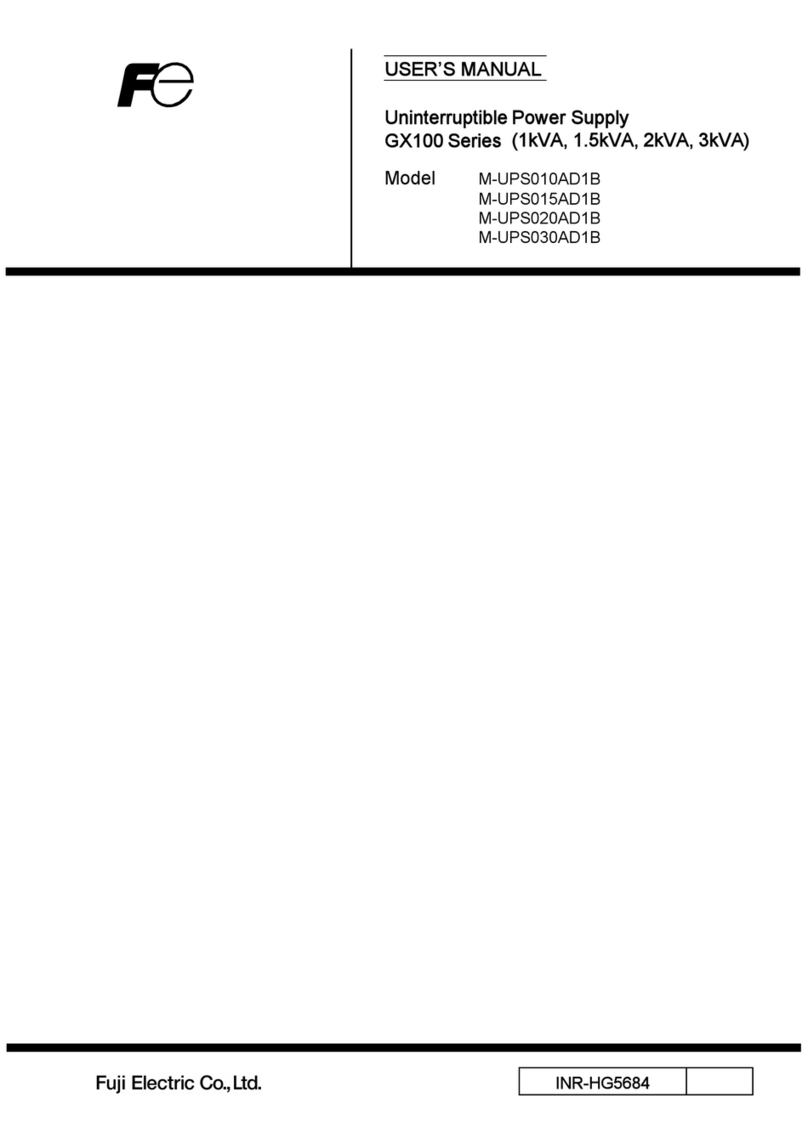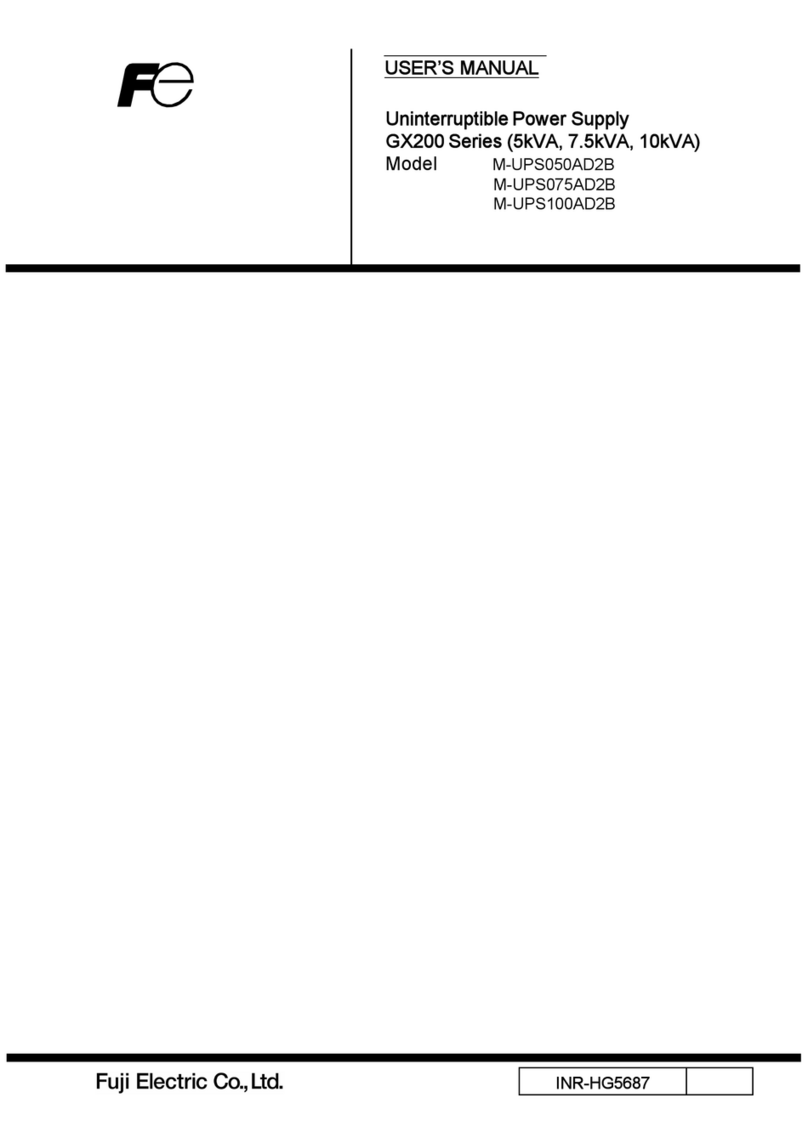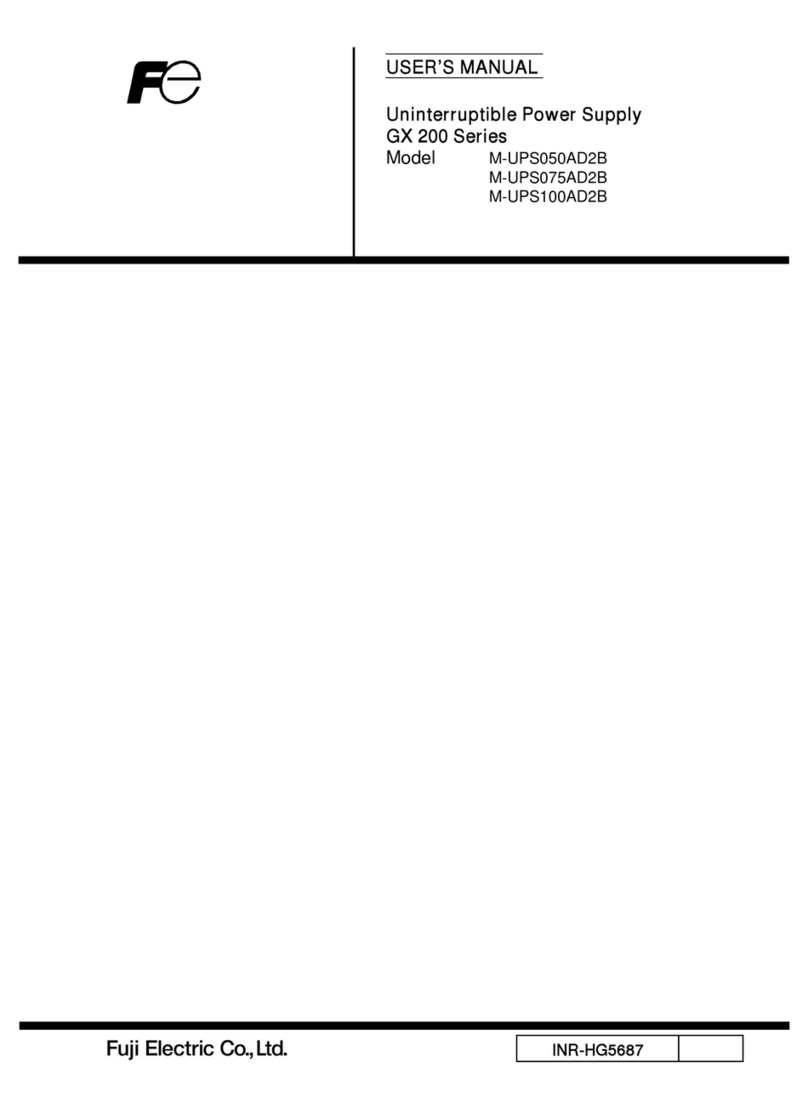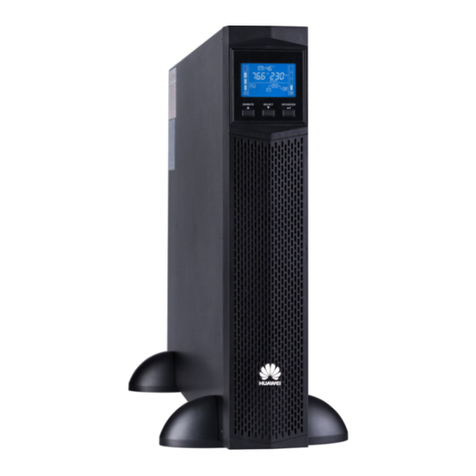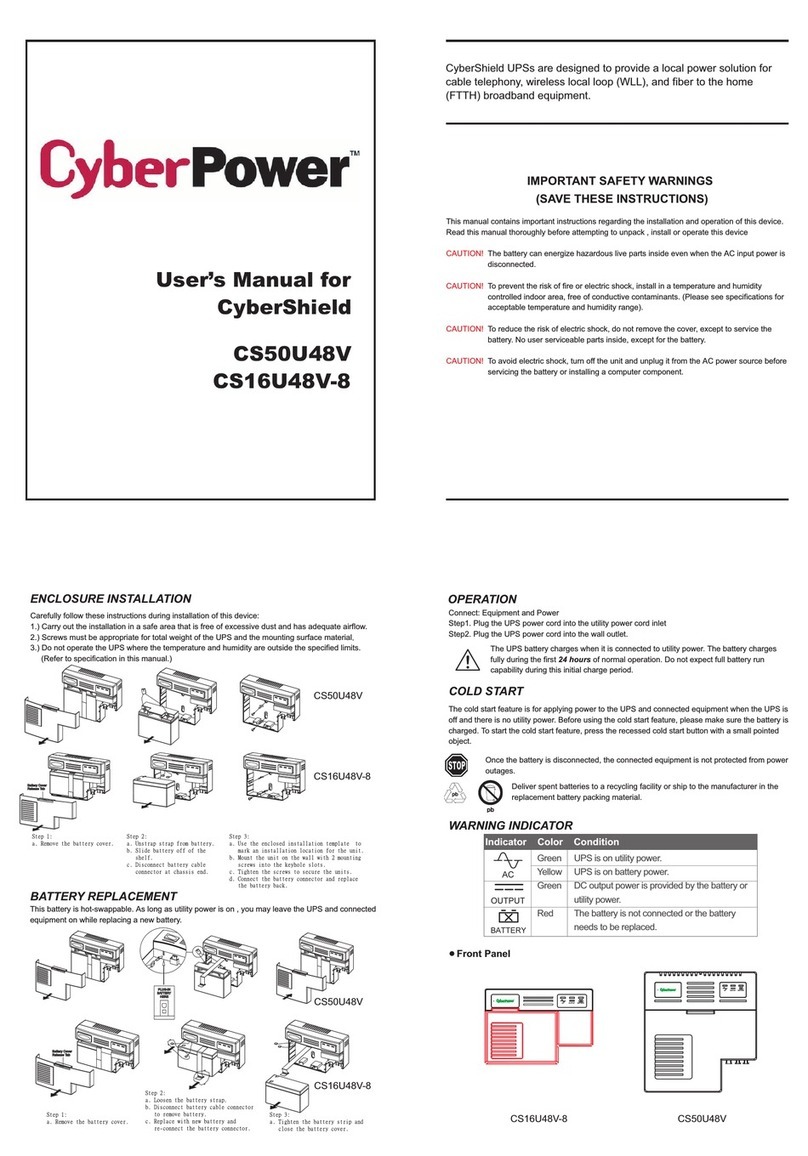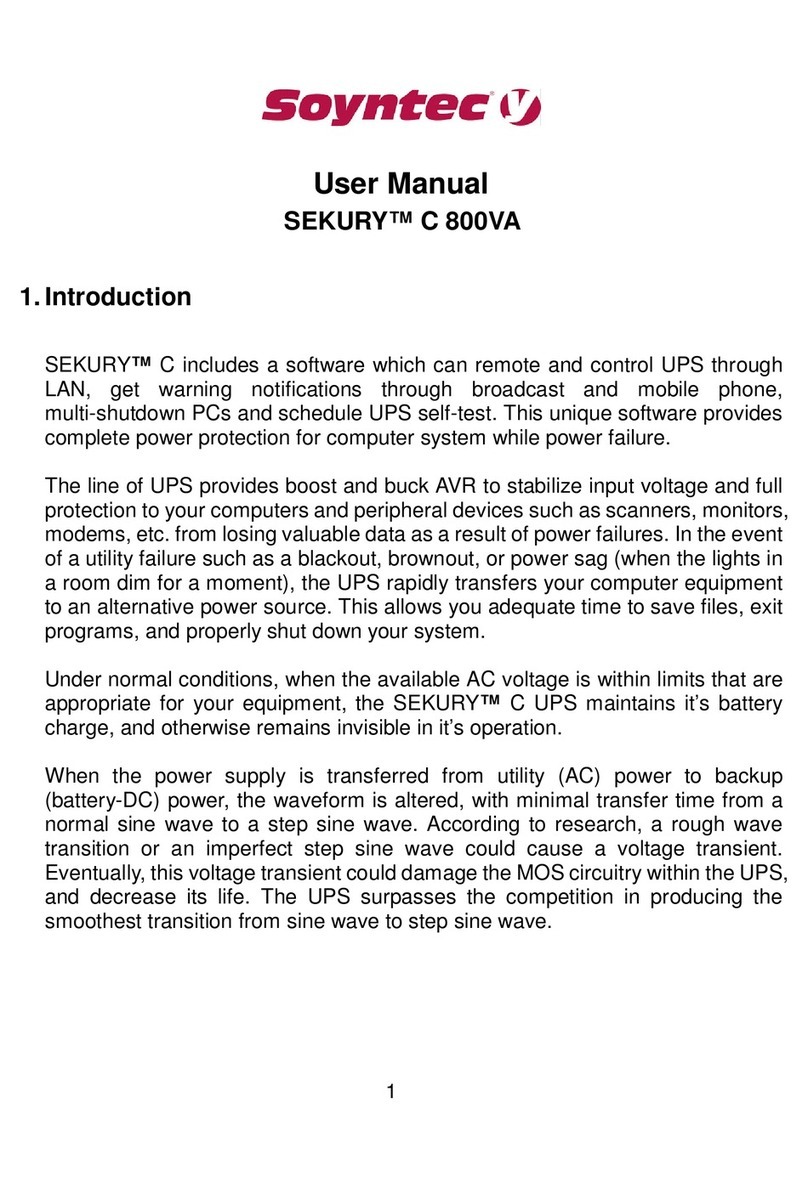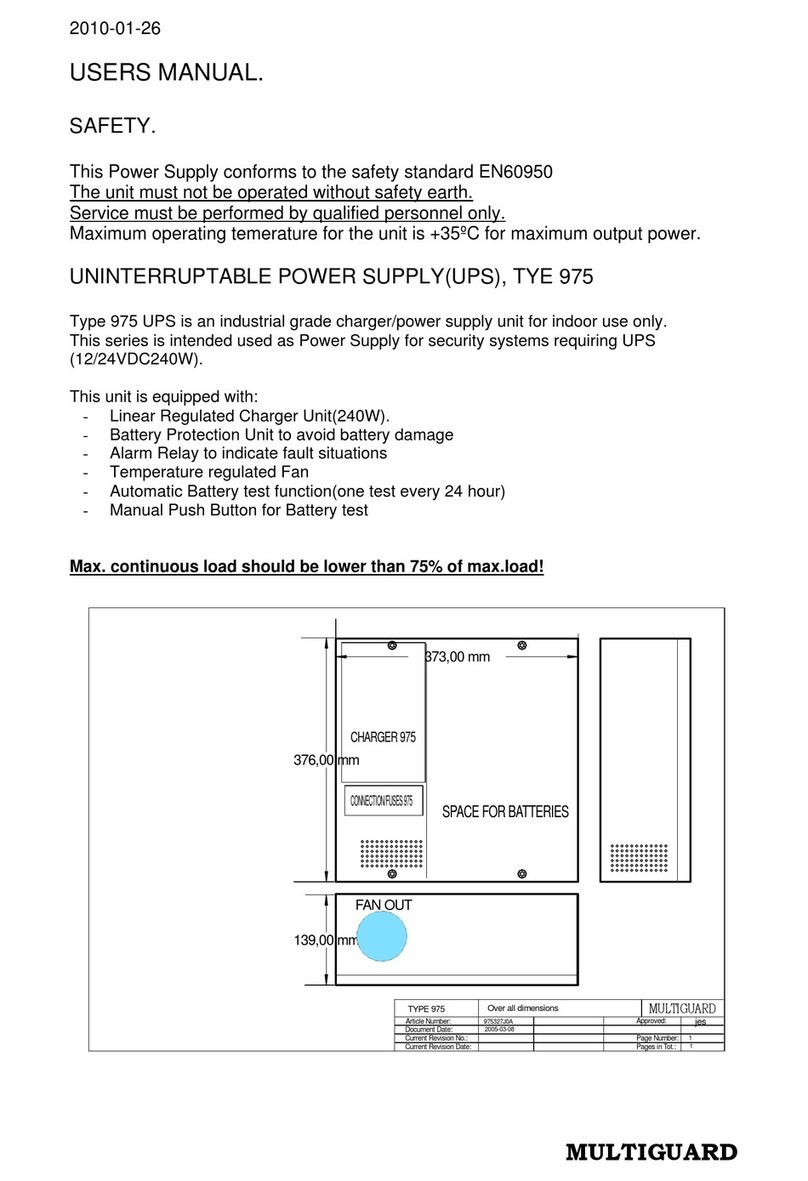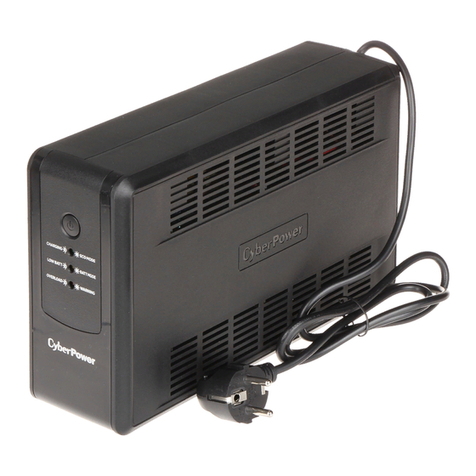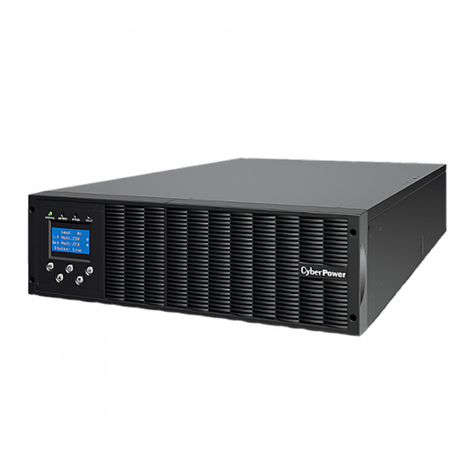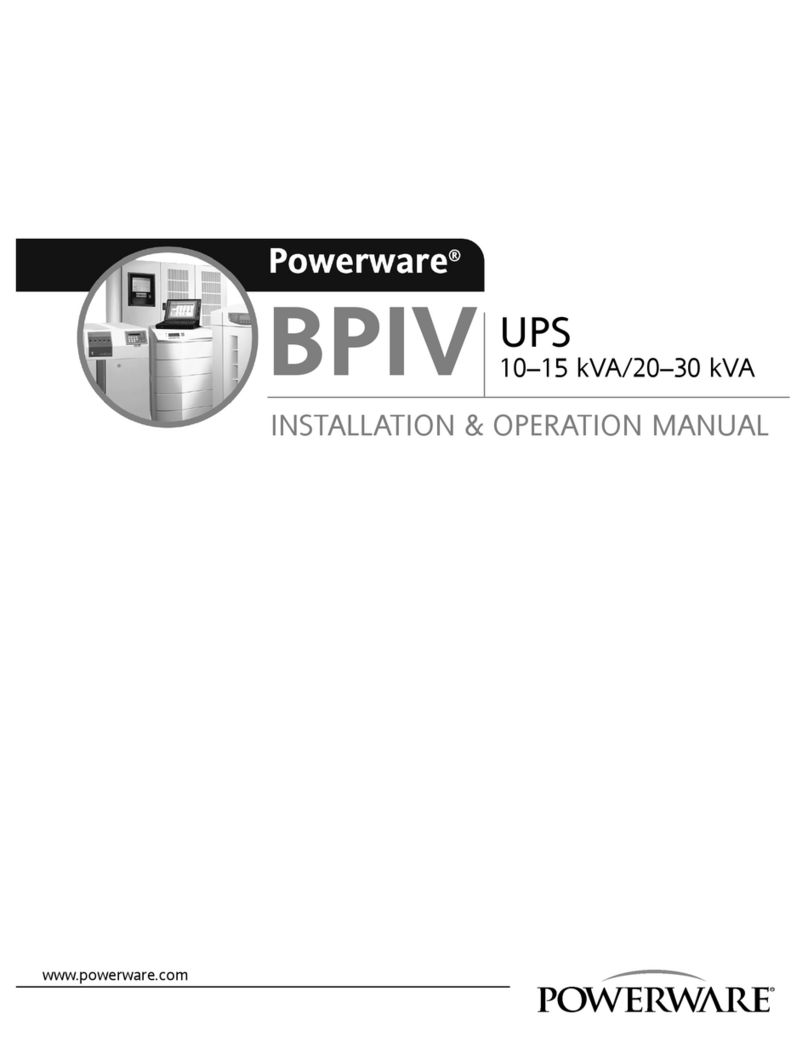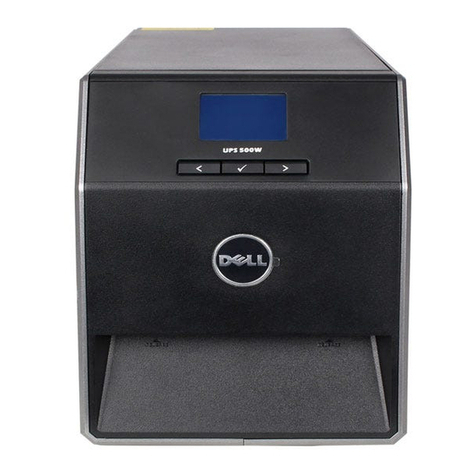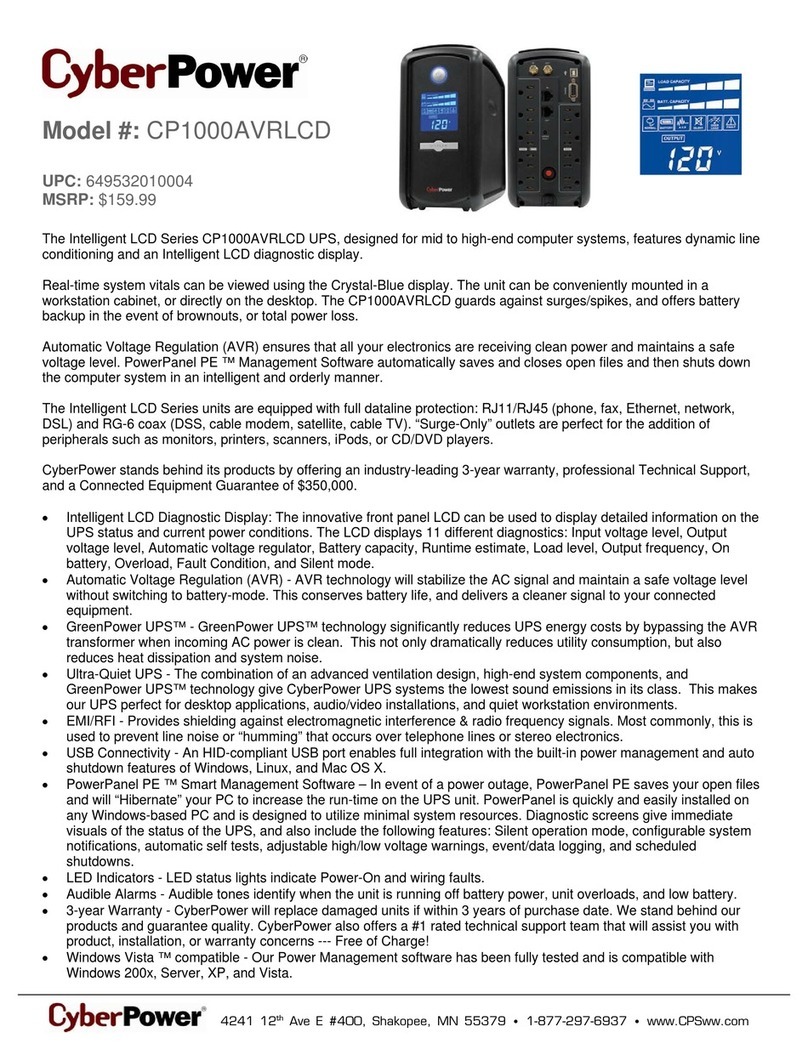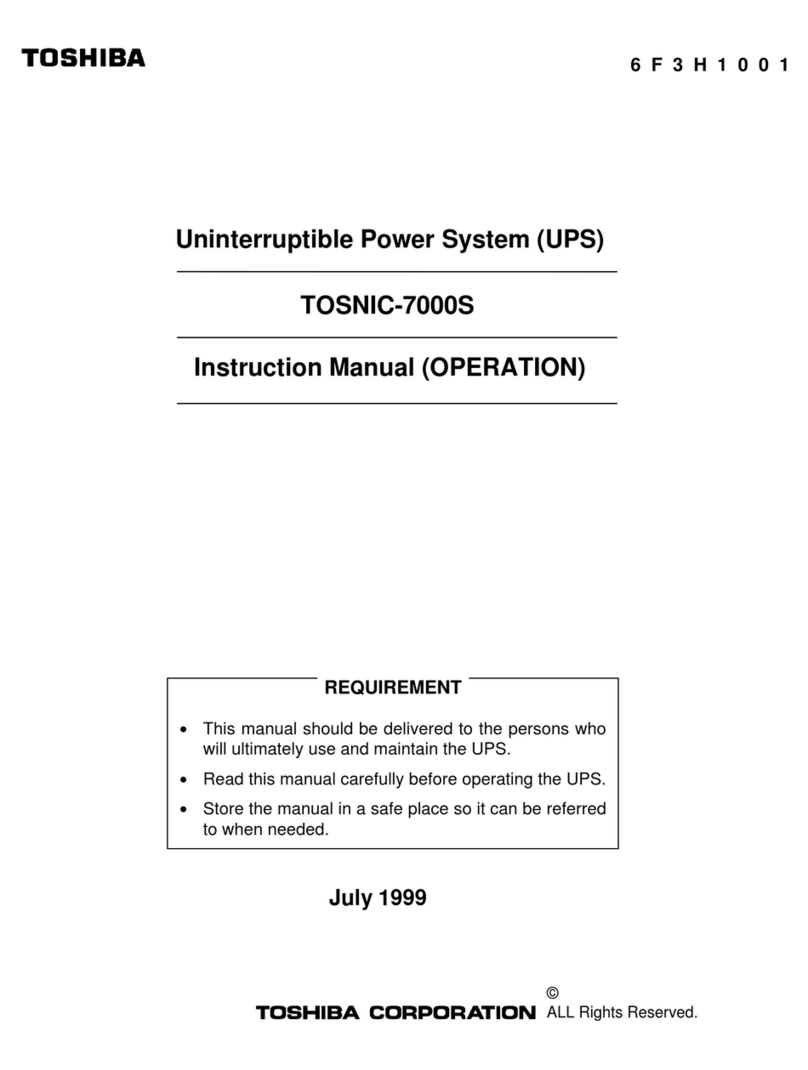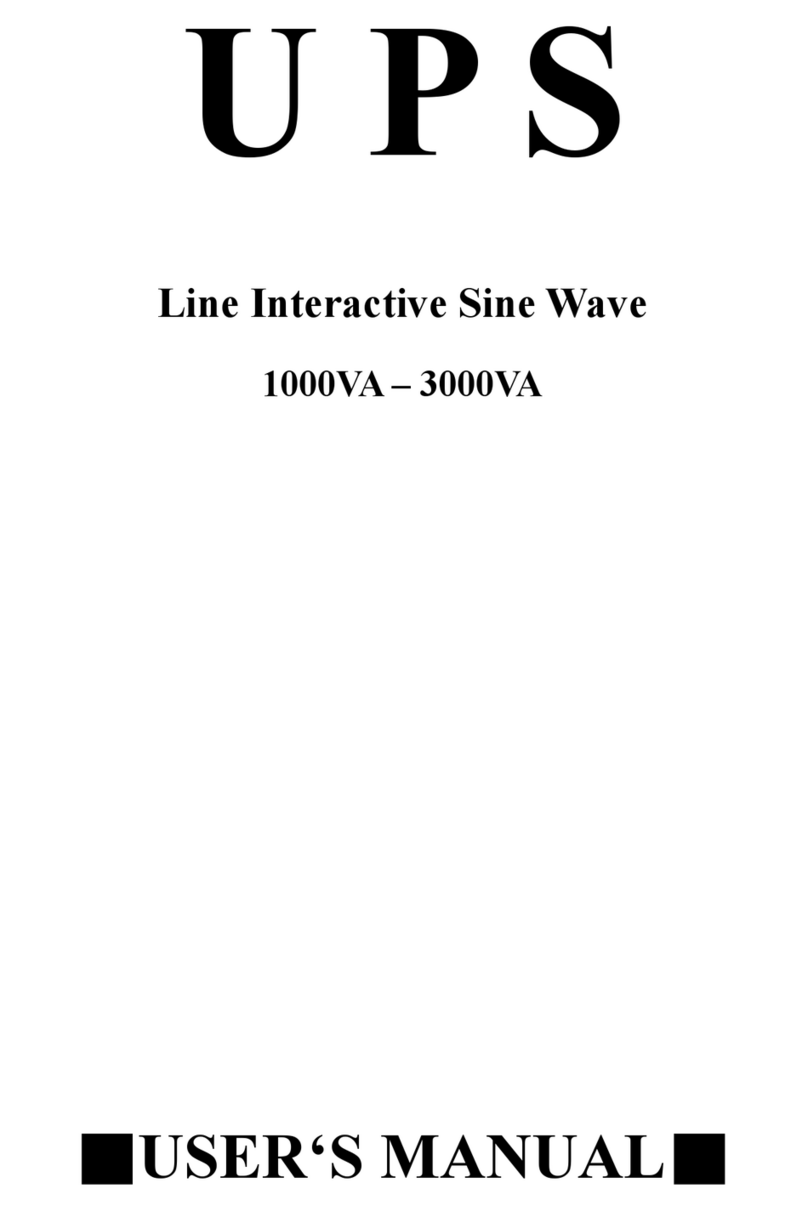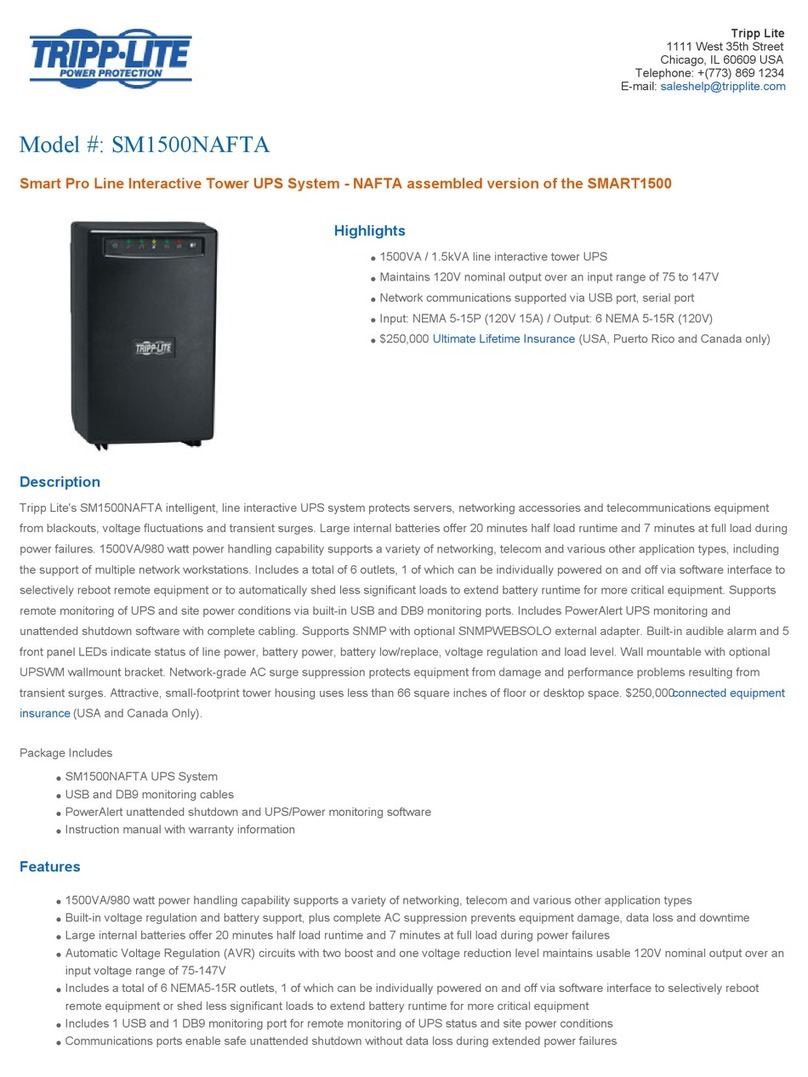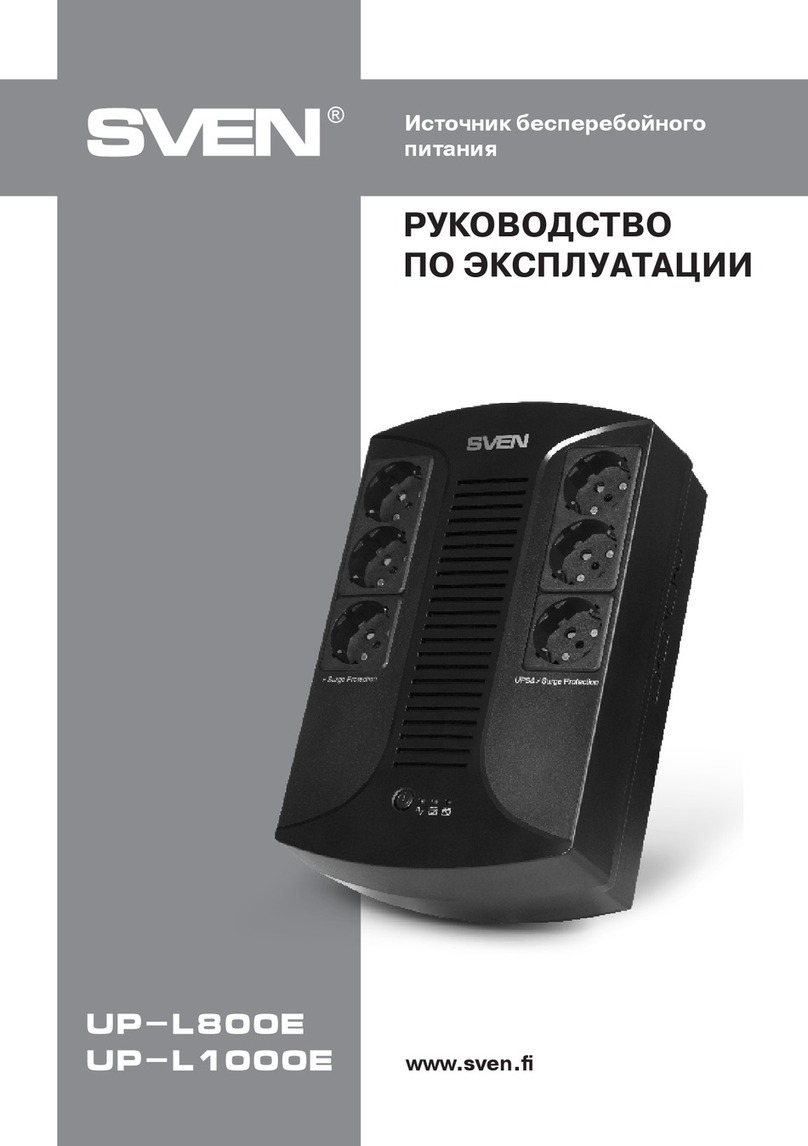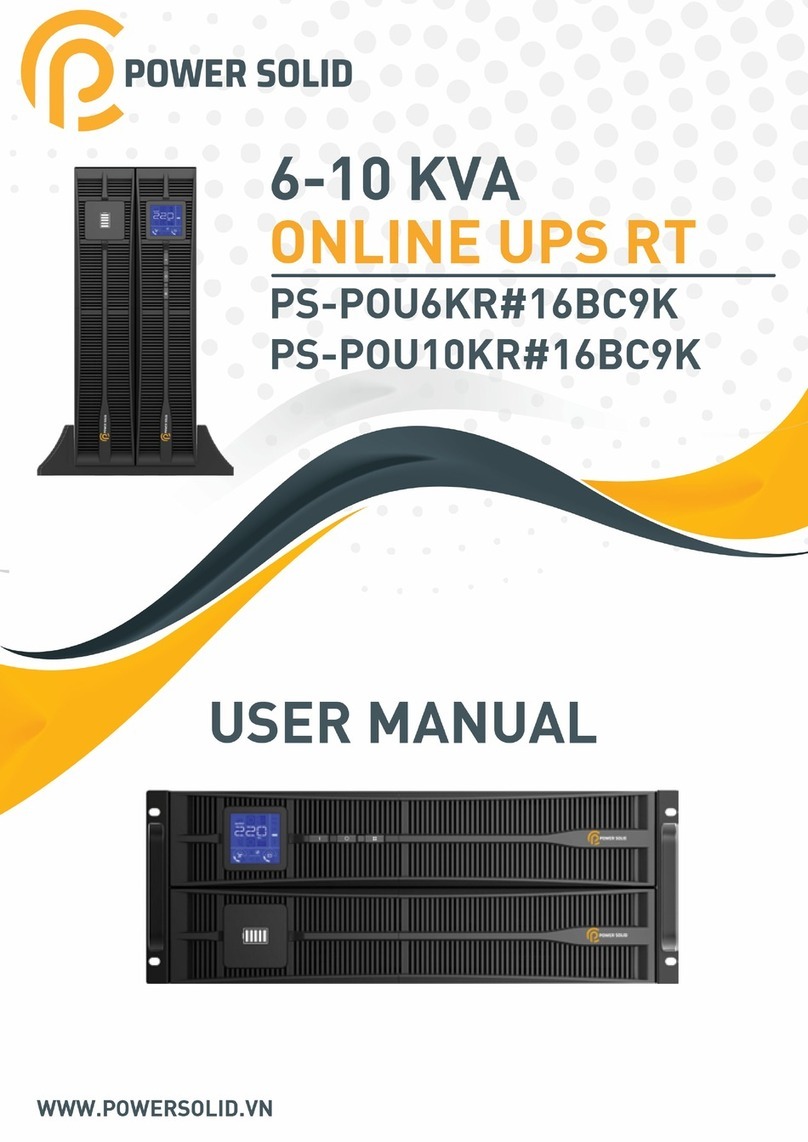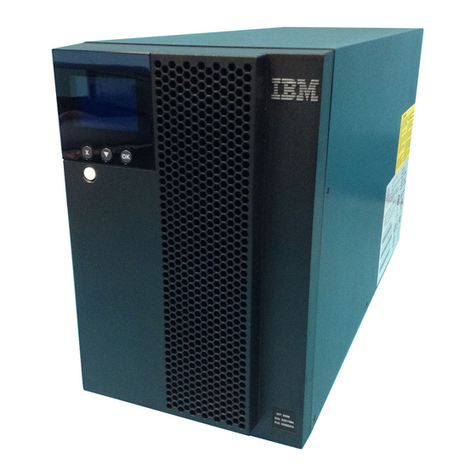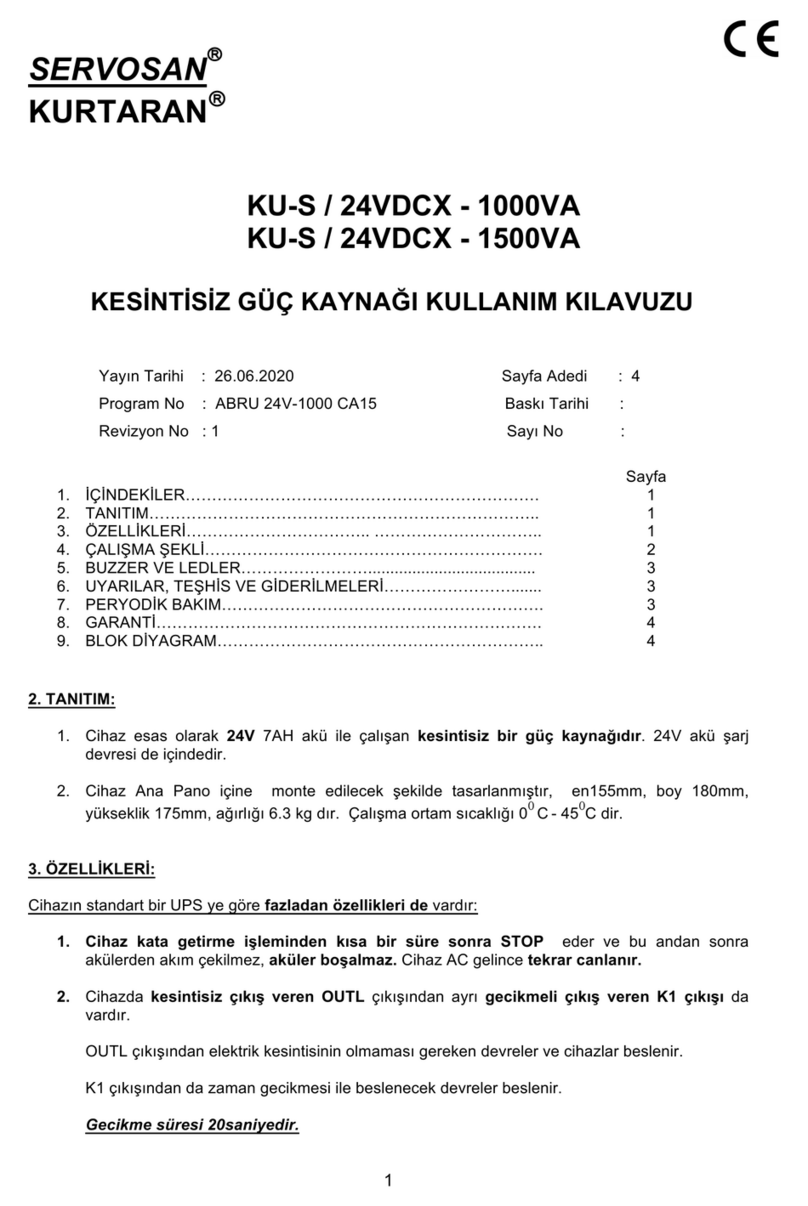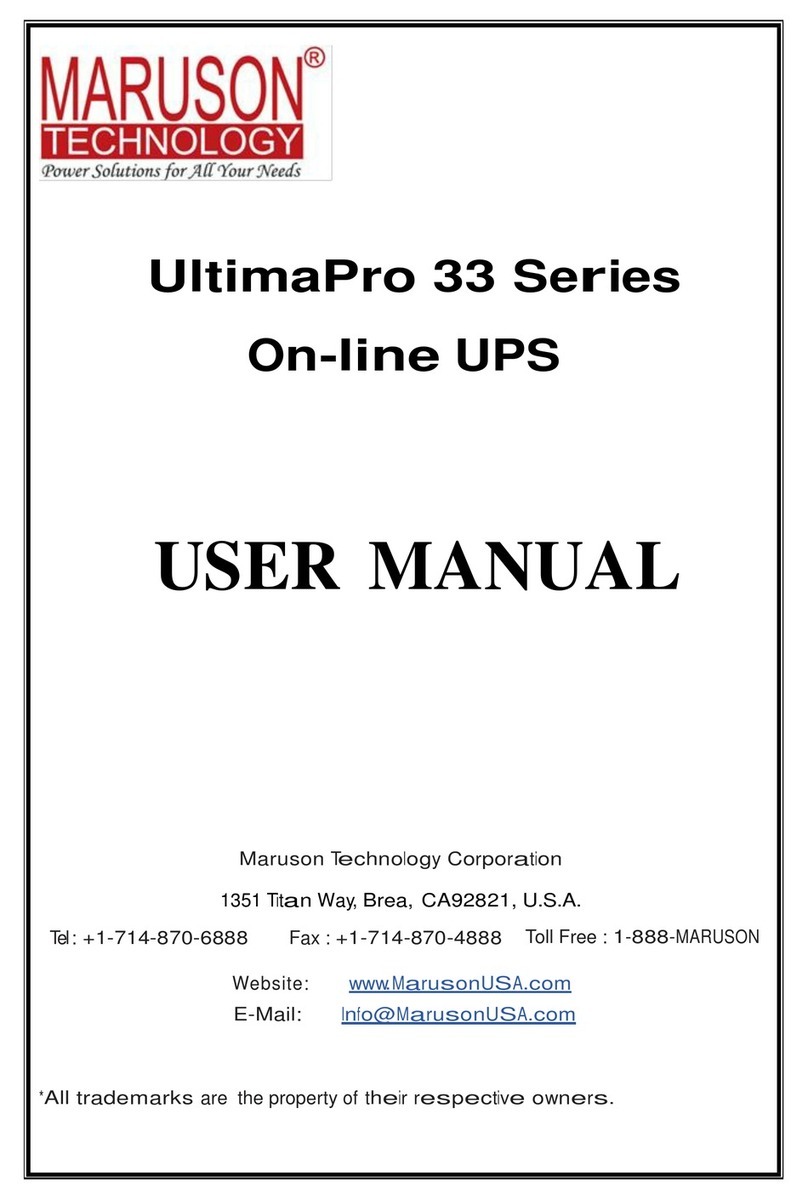FE M-UPS050AD1C User manual

Fuji Electric Co., Ltd.
USER’S MANUAL
Uninterruptible Power Supply
GX 100 Series (5kVA)
Model M-UPS050AD1C
M-UPS050AD1B
INR-HG5411 a

For Safe Use
Handling of this manual
This manual describes important information for using this product safely. Please read
this manual carefully before using this product. Use this product, after reading and
understanding especially “Caution about Safety" and "Caution for Use" in this manual
well. Furthermore, this manual should be retained for future reference.
High-safety Uses
This product is designed and manufactured for the general uses such as a general office
use and a personal use, and it is not designed and not manufactured for uses (hereinafter
called "high-safety uses") that require a high degree of safety, and are hazardous to human
life and body if the required safety is not maintained, such as atomic nuclear command,
aircraft flight control, air traffic control, mass transport control, life supporting system,
and weapon control, etc.). Do not use this product without carrying out measures to
ensure the required safety for high-safety uses. If using this product for high-safety uses,
consult with our sales representatives.
Prevention of Radio Disturbance
Important
This product is class A information technology equipment based on the standard of
Voluntary Control Council for Interference by Information Technology Equipment
(VCCI). Using this product in a residential area may cause radio disturbance. In this
case, the user may be requested to take an appropriate measure.
Prevention of Higher Harmonics Current Disturbance
This product conforms to IEC61000-3-12.
All Rights Reserved, Copyright ○
cFuji Electric Co., Ltd. 2011


i
Introduction
An uninterruptible power supply is a device for supplying stable electric power to OA
devices, FA devices, and computer devices.
This manual describes installation, running, daily management, troubleshooting, and
maintenance of an uninterruptible power supply. Use an uninterruptible power supply
correctly in accordance with this manual.
In this manual, an uninterruptible power supply (this product) is described as UPS for
short.
Content and organization of this manual
The organization of this manual is as follows:
Caution about Safety and Caution for Use
The cautions about safety are described. If you use the UPS, be sure to read this
section.
1 Unpacking
The cautions for taking out the UPS from a box are described.
2 Overview
The name of each part and the operation mode of the UPS are described.
3 Installation
Installation of the UPS and connection of the cable are described.
4 Running
The methods of run and stop of the UPS are described.
5 Inspection
The cautions about daily inspection and rolling blackouts are described.
6 Troubleshooting
Troubleshooting is described.
7 Maintenance
Replacement of battery and cooling fan and method of storing the UPS are
described.
8 Appendix
Rated specification and the additional description for UL type products are described.
Depending on the purpose to use, the chapters which should be especially referred to
are as follows.
For installation personnel Caution about Safety, Caution for Use,
Chapters 1, 2, 3, and 4
For users Caution about Safety, Caution for Use,
Chapters 2, 4, 5, and 6
For maintenance personnel Caution about Safety, Caution for Use,
Chapters 2, 4, 5, and 7

Introduction
ii
Warning indication
In this manual, the following warning indications are described so that user or the people
around the UPS do not suffer damage to the body and property.
Warning
Warning”indicates that death or serious injury may result, if the
UPS is not used correctly.
Caution”indicates that slight or moderate injury may result or
that the UPS or user’s property may be damaged, if the UPS is not
used correctly.
Important “Important”indicates precautions for use of the UPS.
Symbols in this manual
Symbols in this manual have the following meanings:
The state of the UPS is described.
Have a look if necessary. How to deal with, the reference place,
etc. are described.
Attention
Information in this manual is subject to change without notice.
Caution

iii
Caution about Safety
List of important warnings
The important warnings described in this manual are as follows.
Warning”indicates that death or serious injury may result, if the
UPS is not used correctly.
Electric shock
Do not remove the cover of the UPS.
Since there are parts of high voltage inside the UPS, there is the fear
of an electric shock.
Caution”indicates that slight or moderate injury may result or
that the UPS or user’s property may be damaged, if the UPS is
not used correctly.
Put neither a stick nor a finger into the cooling fan or the
vent hole.
Electric shock
Injury There is the fear of an electric shock or an injury.
Electric shock
The maintenance other than daily inspection such as the
replacement of battery or cooling fan must be performed
by the specialist engineer.
There is the fear of an electric shock.
Connect a grounding wire to a ground terminal. (class D
grounding)
There is the fear of an electric shock.
A commercial power source usually has the electrodes of
a grounding side and an ungrounded side separately from
a grounding electrode (earthing). Be sure to check before
connecting.
If connected in reverse, there is the fear of the malfunction by the
noise or an electric shock.
When inspecting or maintaining the connection device (a
device getting connected to the UPS) or the UPS, turn off
the connection device and the UPS. And turn off the input
breaker of the back of the UPS, and cut off connection to
the AC input terminal (R, S).
There is the fear of an electric shock.
Warning
Caution

Caution about Safety
iv
Do not ride on the UPS and not put the objects on top of
the UPS.
Injury
There is the fear of an injury or an overturn.
This UPS is a heavy load. Pay adequate attention to
handling of the UPS.
Injury
Damage
Take out the UPS in the level and flat place. Pay adequate attention
so that an accident such as an overturn or a drop will not occur. The
mass of the UPS is as follows:
M-UPS050AD1C : 84kg (without batteries : 48kg)
M-UPS050AD1B : 78kg (without batteries : 42kg)
This UPS can be also installed transversely. If installing
the UPS transversely, install it in the direction that took
down the UPS to the right side as viewed from the front.
Never install it in the direction that took down the UPS to
the left side.
Fire
Damage
There is the fear of a fire or the UPS failure by the leak of battery.

Caution about Safety
v
Damage Do not use the UPS for the uses that may damage the
human body or exert an important influence on the
society and public.
The medical equipment which has an influence on the human
life directly
The equipment that may damage the human body
The socially and publicly important computer system
Do not put the objects (CRT display or floppy disk, etc.)
that are vulnerable to magnetism around the UPS.
There is the fear of having a bad influence on the objects.
Confirm that the voltage which was set by the voltage
setup switch is within the input voltage range of the
connection device.
There is the fear of damaging the connection device.
Do not operate the voltage setup switch during operation
of the UPS.
There is the fear of damaging the connection device. And even if
operating the switch during operation of the UPS, the output voltage
cannot be changed.
Replace the battery periodically.
If continuing to use the battery that reached the end of battery life,
there is the fear of the leak of battery and a smoke.
For the replacement battery, use the battery specified by
our company, and the new battery.
If using the battery other than the specified battery, or using a new
battery and an old battery in mixture, it becomes the cause of failure
and trouble.
When performing the rolling blackouts or when turning off
the input breaker of the back of the UPS, confirm that the
RUN LED (green) is blinking slowly (in the cycles of
approximately 1.6 sec.).
When the RUN LED is lighting up, if turning off the breaker of
distribution board or the input breaker of the back of the UPS, the
internal battery will be discharged, because it will become the same
condition as a power failure.
There is the fear of the battery damage or the shortening of battery
replacement cycle.
Warning label
A warning label is affixed to the UPS.
Never remove the label.
This warning label is directed to the UPS users.

vi
Caution for Use
Be careful about the following when using the UPS.
Important “Important”indicates precautions for use of the UPS.
Do not install and store the UPS in the following places:
In an outdoor location
A place exposed to the elements
An extremely humid place and a dusty place
A place with corrosive gas or salinity
A place subjected to direct sunlight
A place near sparks or heating element
An extremely hot or cold place, or place where the temperature fluctuates
greatly
A place where vibration and a shock are added
Do not perform the battery check in succession.
When the battery check is performed, the internal battery discharges actually and the
voltage is checked.
If the battery check is performed in succession, there is the fear of the battery damage or
the shortening of battery replacement cycle.
If the UPS is not used for a long time, charge the battery every two
months.
Charge the battery by operating the UPS 12 hours or more every two months, and after
charging the battery, perform the battery check.
If leaving the UPS unused for a long time, the battery becomes an over-discharge state
due to self-discharge and there is fear that the battery becomes impossible to use.
The disposal of used battery has legal restrictions.
Request the disposal to industrial waste disposal contractor or consult with a sales
agency that you purchased the UPS, or the maintenance agency.
Do not block the cooling fan and the vent hole and not use the UPS in a
stuffy place.
The cooling fan and the vent hole are equipped in order to cool the inside of the UPS.
There is fear that the inside and ambient temperature of the UPS get out of the rated
specification.
Replace the cooling fan periodically.
If continuing to use the fan that reached the end of fan life, there is fear that the inside
temperature of the UPS gets out of the rated specification.
Do not use 5 to 9 of the voltage setup switch.
The UPS will become unable to start up normally.

Caution for Use
vii
The allowable voltage between the input electric cable of the UPS and the
ground is 230 VAC.
If applying the voltage of more than 230 VAC, the filter circuit of the input part may be
damaged.
The input surge voltage capacity of the UPS is 5kV peak (1.2 50µs).
However, if the model of the UPS is "-UC", it is 2kV peak (1.2 50µs).
If applying the surge voltage of more than 5kV peak (2kV peak in case of "-UC"), the
filter circuit of the input part may be damaged.
The input voltage of the UPS is 85 to 138 VAC.
When input voltage is different from the rated specification (200 VAC, etc.), install a
transformer at the outside of the UPS to convert voltage. If applying the voltage that
exceeds the input voltage range, the UPS may be damaged.
The input voltage of the UPS should be within the rated input voltage
range of the connection device.
During the bypass operation, the input voltage of the UPS is outputted to the connection
device as the output voltage as it is. If applying the voltage that exceeds the rated voltage
range of the connection device, the connection device may be damaged.
Do not apply the single-line grounding at the output side.
It is not insulated between the input and output of the UPS. Therefore, do not apply the
single-line grounding at the output side.
There is the fear of causing the trouble by the noise or the failure.
When connecting the UPS to a three-phase power supply system, be sure
to connect the grounding phase of the three-phase power supply system
to the electrode of a grounding side of the AC input of the UPS.
If connecting the UPS to an ungrounded power source, there is the fear of causing the
malfunction.
When using a generator temporarily during the rolling blackouts, use a
generator satisfying the following specification.
If connecting a generator not satisfying the following specification to the input part of
the UPS, there is the fear of causing the malfunction or damage of the UPS.
Voltage variation: 85 to 138 VAC
Frequency variation: within ±5% of the rated frequency (1Hz/sec.)
Voltage waveform distortion: within 5%
Voltage zero-cross condition: Zero-cross must not occur more than twice per
cycle.

viii
Index
Introduction.......................................................................................................i
Caution about Safety .....................................................................................iii
Caution for Use...............................................................................................vi
1 Unpacking
1.1 Opening the Packing ...........................................................................1
Opening the packing
Confirming the contents of the packing
2 Overview
2.1 Name and Main Function of Each Part ...............................................2
2.2 Operation Mode of the UPS.................................................................4
At the normal operation
At the battery operation (In the event of an input power failure)
At the bypass operation (In the event of the abnormalities inside the UPS)
3 Installation
3.1 Installing the UPS.................................................................................6
Caution about installation
Determining an installation location
Determining the installation method
Installation method
3.2 Connecting the Cable ........................................................................10
Caution about connecting the cable
Preparation before connecting the cable
Connecting the input and output cable
3.3 Interface Port......................................................................................13
CN1 (No-voltage contact signal interface)
CN2 (RS-232C interface)
3.4 Setting up the Output Voltage...........................................................15
The setup procedures of the rated output voltage
4 Running
4.1 Turning on the UPS............................................................................17
Confirming cable connection
Turning on the UPS
Turning on the connection device
4.2 Turning off the UPS............................................................................20
Turning off the connection device
Turning off the UPS
5 Inspection
5.1 Care and Daily Inspection .................................................................22
How to care for the UPS
Daily inspection

ix
5.2 Caution and Measures for the Rolling Blackouts.............................24
Operation before the rolling blackouts
Operation after the rolling blackouts
5.3 Inspecting the Battery (Battery Check).............................................25
Confirming the state of the UPS
Using the manual check function
Charging the battery
6 Troubleshooting
6.1 If a Warning Beep Sounds .................................................................29
6.2 Operation Mode List...........................................................................30
Types of blink of LED
Types of the warning beep
Operation mode list
7 Maintenance
7.1 Replacing the Battery .......................................................................35
Timing of the battery replacement
The method of battery replacement
Disposal and storage of battery
7.2 Replacing the Cooling Fan ................................................................38
Timing of the cooling fan replacement
The method of cooling fan replacement
7.3 When Not Using the UPS (Storage)...................................................40
Work before storage
If a storage period exceeds two months
8 Appendix
8.1 Rated Specification ............................................................................41
8.2 Additional Description for UL Type...................................................43

1
1Unpacking
1.1 Opening the Packing
Opening the packing
This UPS is a heavy load. Pay adequate attention to handling
of the UPS.
Injury
Damage
Take out the UPS in the level and flat place. Pay adequate attention so that
an accident such as an overturn or a drop will not occur. The mass of the
UPS is as follows:
M-UPS050AD1C : 84kg (without batteries: 48kg)
M-UPS050AD1B : 78kg (without batteries: 42kg)
1. Open the packing box and take out the UPS.
Confirming the contents of the packing
2. Confirm that there is no damage to the appearance of the UPS.
3. Confirm that all accessories are contained.
UPS model Accessories No. of pcs
M-UPS050AD1C
M-UPS050AD1B
User’s manual (this document)
Guarantee (this document)
Bracket (with 6 fixing screws)
1 copy
1 set
If the UPS got damaged or accessories are missing:
Contact a sales agency that you purchased the UPS.
Caution

2
2Overview
2.1 Name and Main Function of Each Part
This chapter describes the name and main function of each part of the UPS.
(1)
(2)
(3)
(4)
(5)
(6)
(7)
(8)
(9)
(10)
(11)
(14)
(13)
(12)
(15)
(16)
(18)
(17)

2.1 Name and Main Function of Each Part
3
Name Main function
(1)
RUN It blinks (green) when the UPS is connected to an input power
source.
It lights up (green) while the UPS is operating normally.
(2)
ALARM It lights up (orange) when the abnormalities occurred inside the
UPS.
(3)
OVER LOAD It lights up (orange) when the load capacity of the connection
device exceeded the rated specification.
(4)
BYPASS It lights up (orange) while the UPS is performing the bypass
operation.
(5)
LED
BATTERY
CONDITION
When the battery is normal, it indicates the amount of battery
charge according to the type (lights out, blinking, or lighting) of
lighting (green).
When the battery is abnormal, it lights up (orange).
(6)
RUN/STOP It is the switch for performing the operation and stop of the UPS.
The operation and stop are switched each time one presses the
switch for approximately 1 second.
(7)
RESET Press this switch when stopping the warning beep. Also, if
pressing the switch for approximately 3 seconds after restoring the
failure, the ALARM LED goes out.
(8)
BATT CHECK It is the switch for performing the battery check manually. By
pressing the switch for approximately 2 seconds, the battery check
is performed.
Switch
BYPASS
If switching to the bypass operation forcibly (manually) while the
UPS is operating normally, press the switches (7) and (8)
simultaneously for approximately 3 seconds. When pressing the
switches simultaneously for approximately 3 seconds again, the
UPS returns to the normal operation.
(9)
Vent hole It ventilates the inside of the UPS. The direction of air is intake.
(10)
Cooling fan It cools the inside of the UPS. The direction of air is exhaust.
(11)
Input terminal block Connect the UPS to an input power source.
(12)
Input breaker It is the breaker for protecting the input circuit.
(13)
Output terminal block Connect the UPS to an output system.
(14)
Ground terminal Connect a grounding wire.
(15)
Voltage setup switch Set the output voltage.
(16)
Interface slot Mount various interface cards.
(17)
Contact signal (CN1) It outputs a no-voltage contact signal.
(18)
RS-232C (CN2) It is a RS-232C interface.

2Overview
4
2.2 Operation Mode of the UPS
At the normal operation
While the UPS is operating normally, the UPS operates an AC power supply as an
input, and supplies the output of constant voltage to connection device. Simultaneously,
the UPS charges an internal battery and prepares for the battery operation.
Output frequency is synchronized with input frequency.
+
Bypass
AC/ACconverter
Boostchopper
BatteryCharger
[UPS]
Toconnectiondevice
:Powerisfed
:Powerisnotfed
Output
Inputpowersource
Flow of electricity during normal operation
At the battery operation (In the event of an input power failure)
When the voltage or the frequency of an AC input power source is abnormal, the UPS
starts the electric discharge from the battery, and continues to supply the stable electric
power to the connection device. In addition, the changeover to the battery operation is
performed without instantaneous interruption.
If the input power source returns, the UPS will return to the above normal operation
automatically.
+
Bypass
AC/ACconverter
Boostchopper
BatteryCharger
[UPS]
Toconnectiondevice
:Powerisfed
Theabnormalities
occurataninput
powersource.
WhiletheUPSisoperating,
-Theabnormalitiesofvoltage
-Theabnormalitiesoffrequency,etc.
:Powerisnotfed
Output
Flow of electricity during battery operation

2.2 Operation Mode of the UPS
5
At the bypass operation (In the event of the abnormalities
inside the UPS)
When the abnormalities occur inside the UPS, an output switching circuit switches to a
bypass circuit, and continues to supply electric power through the bypass circuit to the
connection device.
In addition, changeover between circuits can switch without instantaneous interruption.
It is also the same as when switching to the bypass operation manually with the switch
on the front of the UPS.
At the bypass operation, electric power is not supplied (battery operation) from the
battery to the connection device.
+
Bypass
AC/ACconverter
Boostchopper
BatteryCharger
[UPS]
Toconnectiondevice
:Powerisfed
Theabnormalities
occurinsidethe
UPS
-TheabnormalitiesinsidetheUPS
-Manualchangeovertothebypass
operation
:Powerisnotfed
Output
Inputpowersupply
Electricity flow during bypass operation

6
3Installation
3.1 Installing the UPS
Caution about installation
Injury Do not ride on or put an object on the UPS.
There is fear of an injury or an overturn.
Damage Do not put an object (CRT display or floppy disk, etc.)
vulnerable to magnetism around the UPS.
There is fear of exerting a bad influence on the object.
Determining an installation location
Important
Do not install the UPS in the following places:
In an outdoor location
A place exposed to the elements
An extremely humid place and a dusty place
A place with corrosive gas or salinity
A place subjected to direct sunlight
A place near sparks or heating element
An extremely hot or cold place or place where the temperature fluctuates
greatly
A place where vibration and a shock are added
Do not use the UPS in a residential area or its adjacent area.
This UPS is class A information technology equipment based on the standard of
Voluntary Control Council for Interference by Information Technology Equipment
(VCCI). Using this UPS in a residential area may cause radio interference. In this case,
the user may be requested to take an appropriate measure.
Do not block the vent hole and cooling fan or use the UPS in a stuffy
place.
The vent hole and cooling fan are equipped in order to cool the inside of the UPS.
There is a possibility that the inside and ambient temperature of the UPS may get out
of the rated specification.
Caution

3.1 Installing the UPS
7
The following spaces are required for an installation location.
The UPS takes in air through the vent hole on the front of the UPS and
exhausts air through the cooling fan on the back of the UPS. Therefore, the
space of 10cm or more is required in the front and rear of the UPS.
When performing maintenance of the UPS:
The space of approximately 1m is required in the front and rear of the UPS.
Confirm the environment of the installation location. The recommended environment in
consideration of the battery life, etc. is as follows.
Item Recommended environment
Temperature 15 to 25 degrees C
Humidity 30 to 70% (no condensation)
10cm
or more UPS
Frontside
Rearside
Intake
air
10cm
or more
Right side
Exhaust
air
UPS
Front side
Rear side
Right side
Space for
battery
maintenance
Space for
maintenance
1m or more 1m or more
UPS
Front side
Rear side
Right side
Space for
battery
maintenance
Space for
maintenance
1m or more 1m or more

3Installation
8
Determining the installation method
This UPS can be installed laying down. If installing laying the
UPS down, tilt it only to the right side, seeing from the front.
Never tilt the UPS to the left side.
Fire
Damage
There is fear of a fire or the UPS failure owing to a leak of battery.
This UPS can be put in a 19-inch rack using the optional rack mount
attachment kit.
Caution
This manual suits for next models
1
Table of contents
Other FE UPS manuals
